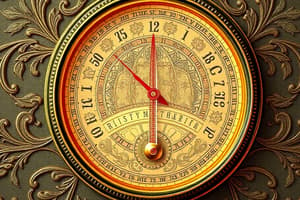Podcast
Questions and Answers
The bulb of extreme thermometers (Max & Min) is placed higher than the stem when mounted on suitable supports.
The bulb of extreme thermometers (Max & Min) is placed higher than the stem when mounted on suitable supports.
False (B)
Field checks and calibration for liquid-in-glass thermometers should be done once a year to prevent zero changes.
Field checks and calibration for liquid-in-glass thermometers should be done once a year to prevent zero changes.
False (B)
It is recommended to store thermometers in a horizontal position at room temperature before starting the checking process.
It is recommended to store thermometers in a horizontal position at room temperature before starting the checking process.
False (B)
The ice point calibration can be done by filling a Dewar flask with crushed ice made from tap water.
The ice point calibration can be done by filling a Dewar flask with crushed ice made from tap water.
National testing institutions are responsible for carrying out field checks and calibrations of thermometers.
National testing institutions are responsible for carrying out field checks and calibrations of thermometers.
Thermometers in a thermometer screen placed on a support are always exposed to direct sunlight.
Thermometers in a thermometer screen placed on a support are always exposed to direct sunlight.
Extreme thermometers (Max & Min) are inclined at an angle of about 2° from the vertical position.
Extreme thermometers (Max & Min) are inclined at an angle of about 2° from the vertical position.
Laboratory calibration of liquid-in-glass thermometers should be done using a liquid bath.
Laboratory calibration of liquid-in-glass thermometers should be done using a liquid bath.
It is necessary to allow at least 15 minutes for the thermometer to adjust to the ice temperature before taking a reading during ice point calibration.
It is necessary to allow at least 15 minutes for the thermometer to adjust to the ice temperature before taking a reading during ice point calibration.
Regular checking of liquid-in-glass thermometers is recommended to prevent sudden zero changes.
Regular checking of liquid-in-glass thermometers is recommended to prevent sudden zero changes.
Flashcards
Liquid bath calibration?
Liquid bath calibration?
Laboratory calibration of liquid-in-glass thermometers should be done using a liquid bath for accuracy.
Ice point calibration time?
Ice point calibration time?
Allow at least 15 minutes for thermometer adjustment to the ice temperature before taking a reading during ice point calibration to ensure accurate reading.



